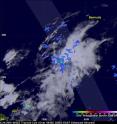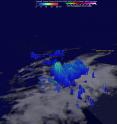NASA's GPM satellite sees potential Atlantic tropical cyclone
Related images
(click to enlarge)
An area of low pressure designated as System 90L, located in the Atlantic Ocean between Bermuda and the Bahamas is being monitored today for possible development into a tropical or subtropical cyclone. The Global Precipitation Measurement (GPM) mission core observatory satellite flew over the developing low pressure area on May 26, 2016 at 0932 UTC (5:30 a.m. EDT). Shower activity has increased in the area. NOAA's National Hurricane Center (NHC) has advised interests along the southeastern coast of United States to monitor the progress of this low.
If System 90L develops into a tropical cyclone it would be the second in the North Atlantic this year. The first was Hurricane Alex that developed in January in the far eastern Atlantic.
GPM's Microwave Imager (GMI) and Dual-Frequency Precipitation Radar (DPR) instruments measured precipitation around the low. Rain was measured by GPM's radar (DPR) falling at a rate of almost 32 mm (1.3 inches) per hour in an area near the center of the low's circulation. Increasing shower activity near the center of a tropical low can signal tropical cyclone development. Tropical cyclones derive energy from the heat generated by condensation that occurs within showers and thundershowers.
Data from GPM's DPR was used to the show the 3-D vertical structure of rainfall within the potential cyclone. Some storm top heights in an area of heaviest rainfall were found to reach heights of over 13 km (8 mile). GPM is a joint missions between NASA and the Japanese space agency JAXA.
At 8:25 a.m. EDT on May 26, the National Hurricane Center (NHC) said that System 90L is centered between Bermuda and the Bahamas. NHC noted that the low is gradually becoming better defined while shower activity is increasing. Environmental conditions are expected to become more conducive for tropical or subtropical cyclone formation on Friday while the system moves west-northwestward or northwestward toward the southeastern United States coast.
NHC noted: "With the Memorial Day weekend approaching, all interests along the southeast coast from Georgia through North Carolina should monitor the progress of this low." The system has a medium chance to develop in the next two days and a high chance to develop in to a subtropical or tropical cyclone over the next five days.
Source: NASA/Goddard Space Flight Center
Articles on the same topic
- NASA looks at winds in developing tropical cycloneFri, 27 May 2016, 19:25:13 UTC
Other sources
- NASA looks at winds in developing tropical cyclonefrom PhysorgFri, 27 May 2016, 19:21:04 UTC
- NASA's GPM satellite sees potential Atlantic tropical cyclonefrom PhysorgThu, 26 May 2016, 18:01:08 UTC
- Satellite Swarm Delivers Worldwide Precipitation In Most Detail Yet | Videofrom Live ScienceMon, 23 May 2016, 22:35:27 UTC
- Satellite Swarm Delivers Worldwide Precipitation In Most Detail Yet | Videofrom Space.comMon, 23 May 2016, 22:27:21 UTC

